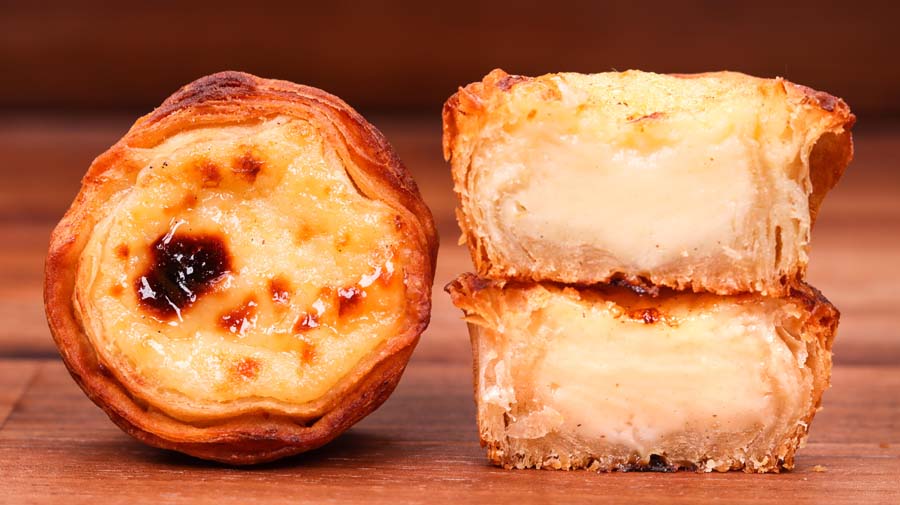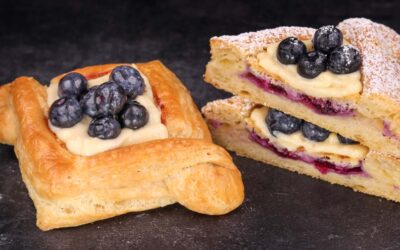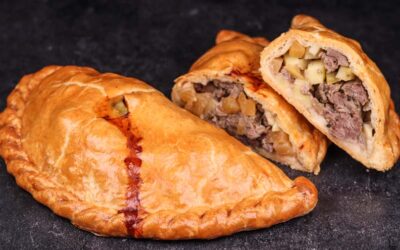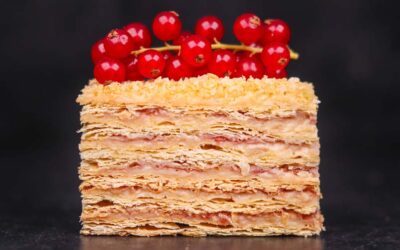Portuguese custard tarts are not very sweet. The filling is nice and light, and the pastry is so crispy that it shatters as you bite through it. It is one of those treats that has a long history and tradition attached to it. But as you may have noticed this channel is about the baking process itself and not about history. So, don’t be mad at me my Portuguese friends. This is just my interpretation of this delicious little pastry.
These pastéis are super light and the pastry is incredibly crunchy and I’m extremely happy with it. This recipe makes 12 small pastéis that fit perfectly in a muffin tin with 2.5in (6.3cm) x 1.5in (3.8cm) moulds.
Watch the video down below for detailed instructions.
Ingredients
For the pastry –
140g (4.9oz) plain flour
90g (3.15oz) water
1g (0.035oz) salt
90g (3.2oz) soft spreadable butter
For the filling –
20g (0.7oz) plain flour
30g (1oz) milk
120g (4.2oz) milk (this is not a typo)
5g (0.17oz) vanilla paste
80g (2.8oz) water
120g (4.2oz) caster sugar
1 cinnamon stick
3 egg yolks
Method
- Make the pastry. Combine the flour, salt, and water. Cover and leave to rest for 30 minutes. This resting stage replaces the kneading process.
- Heavily dust the table and the dough with flour. Roll the dough out to a large square.
- Brush 2/3 of the dough with the softened butter. Fold the 1/3 of plain dough over and then cover it with the remaining 1/3 of buttered pastry. We have the first three layers of our pastry.
- Roll the pastry out again as much as you can. It will resist at this point and if you are struggling, then you can leave it to rest for a few minutes before continuing.
- Brush 2/3 of the pastry with the softened butter. Fold the 1/3 of plain pastry over and then cover it with the remaining 1/3 of buttered pastry. We now have 9 layers.
- Wrap the pastry in clingfilm and refrigerate for 30 minutes.
- Roll it out to a large square. This time brush the whole surface with butter. Trim the very top and bottom of the pastry and then roll it up into a tight log. Pinch the seam together at the end. Many more layers have been created.
- Wrap in clingfilm and refrigerate until it has set. It took around 1 hour for me. You can leave it in the fridge for a few days even.
- Make the custard mix. In a small bowl whisk the 20g plain flour with the 30g milk to a smooth paste. Leave on the side.
- Combine the 120g milk with the vanilla paste in a pan and bring up to a boil.
- Pour the hot milk over the flour/milk paste and whisk until smooth.
- Combine the water, sugar, and cinnamon stick in a pan and bring up to a boil. Remove the cinnamon stick and pour the syrup into the bowl with the milk/flour mix. Whisk until combined.
- Leave the mix to cool down to below 60C (140F). Whisk in the egg yolks. Cover the custard mix and leave it on the side. You can refrigerate it for a few days just like the pastry.
- Once you are ready to bake pre-heat the oven to 250C (482F) fan off. Make sure it is well pre-heated for at least 30 minutes. If you have a baking stone or steel, then I would suggest using it. A thick base will ensure that the bottom bakes properly.
- Brush the muffin tin with butter. Trim the edges of the pastry log and cut the pastry into 12 equal pieces.
- Place the pieces in the muffin tray. Gently press the pastry down and out sideways using your thumbs. You want the bottom to be as thin as possible and the sides to be nice and even. The pastry should cover the whole surface of the muffin mould.
- Pour the custard mix into the pastry cases and bake for 10 – 12 minutes until the surface of the custard has slightly burned and the sides of the pastry look golden brown.
- Remove from the muffin tin, leave to cool down.
Enjoy with a dusting of icing sugar and cinnamon alongside a black coffee.
Watch the video here



